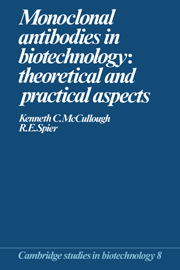Book contents
- Frontmatter
- Contents
- Acknowledgements
- 1 Introduction: the immune response
- 2 Making hybridomas (hybridoma technology)
- 3 Factors affecting successful hybridoma production
- 4 Selection of monoclonal antibody-secreting hybridoma cell lines
- 5 The large-scale production of monoclonal antibodies in vitro
- 6 In conclusion: the diversity in application of monoclonal antibodies and hybridoma technology
- References
- Index
2 - Making hybridomas (hybridoma technology)
Published online by Cambridge University Press: 23 November 2009
- Frontmatter
- Contents
- Acknowledgements
- 1 Introduction: the immune response
- 2 Making hybridomas (hybridoma technology)
- 3 Factors affecting successful hybridoma production
- 4 Selection of monoclonal antibody-secreting hybridoma cell lines
- 5 The large-scale production of monoclonal antibodies in vitro
- 6 In conclusion: the diversity in application of monoclonal antibodies and hybridoma technology
- References
- Index
Summary
Chapter 1 described the interactions and communications which occur during an immune response against non-self material (antigen). From this, it can be seen how hybrid cell lines could be produced which would secrete antibody reactive against a particular antigen. In this chapter, the requirements for the production of such hybrid cell lines–hybridomas – will be explained. The two major factors involved are the use of a tissue-culture-adapted lymphoblastoid cell line (myeloma cell line) and antigen-stimulated (in vivo or in vitro)lymphocytes. The characteristics and production of myeloma cells will be described; details of how these cells play a major role both in the production of hybridomas, through chemical-induced fusion with the antigen-stimulated lymphocytes, and in subsequent stabilisation of the hybrid cells in vitro will be presented. Procedural requirements for generating antigen-stimulated lymphocytes which are to be used in hybridoma production will be explained; and §2.6 will present a practical guide to the preparation of the myeloma cells and lymphocytes, fusion to produce hybridomas and selection of myeloma cell-lymphocyte hybrid cells. Since this book is concerned with antibody-secreting hybridomas, most of the details will be concerned with these; but reference will be made to other types of lymphocyte derived hybrid cell lines, in particular in §2.7.
Basic requirements
The basic constituents of any hybridoma or hybrid cell line are the parent cells required for its formation.With the immune B cell hybridomas (which secrete antibody) these parents are splenocytes from the appropriate animal immunised with the antigen of choice, and tissue-culture adapted myeloma cells (1–6).
- Type
- Chapter
- Information
- Monoclonal Antibodies in BiotechnologyTheoretical and Practical Aspects, pp. 90 - 137Publisher: Cambridge University PressPrint publication year: 1990
- 1
- Cited by



